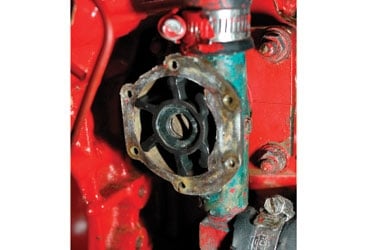
impeller 368
The design is so simple: It has only a handful of parts, and only two of those move. It completes millions of revolutions during its life, and most vessel operators never give it a second thought-until it fails. Without it, your engine is just so much ballast. Figured it out yet? I’m referring, of course, to your engine’s raw-water pump. This is the device that draws water-fresh or salt, whatever your boat happens to be floating in-and supplies it to the engine for cooling purposes.
The basic design of the raw-water pump hasn’t changed much in more than half a century. A flexible impeller turns within an eccentrically shaped housing. As each impeller blade passes a cam, the blade is deformed or
compressed. This compressing action causes the volume between each pair of blades to change rapidly, which in turn causes suction and, thus, water movement. This is referred to as a variable volume-type pump. It’s a brilliant design, to be sure. Like a cutless bearing, the impeller is lubricated as it spins within the pump
housing by nothing more than the raw water beneath you.
Nearly all raw-water-pump impellers are made of neoprene, a synthetic rubber that possesses the twin attributes of resiliency and abrasion resistance. As many a cruiser has discovered, though, they’re far from indestructible. The average impeller can be expected to last several hundred hours, and sometimes more. However, despite manufacturers’ recommendations to the contrary, the prudent skipper will replace the impeller seasonally or every 250 hours, whichever comes first. Barring such catastrophic events as a severe intake clog, impellers that are replaced regularly almost never suffer failures, period. Some manufacturers offer “run dry” impellers, which are designed to endure running without lubricating water for as long as 15 minutes. For more information on this type, see the website for Globe Composite Solutions (www.globerubber works.com).
Impellers can be notoriously difficult to remove from pump housings, particularly when they haven’t been replaced regularly. When you undertake impeller removal, avoid the temptation to use a screwdriver as a pry bar because the only surface against which you can gain leverage is the spot on the pump body where the cover-plate gasket is fitted. Most raw-water pumps are made of brass or bronze, so they’re easily deformed by this action, which can lead to chronic leakage after reassembly. Instead, grab the impeller with a pair of channel-lock pliers or use a dedicated impeller-removal tool.
In addition to the impeller, raw-water pumps contain other components that may require periodic service, repair, or replacement. The pump’s cover plate and cam eventually wear out because of continuous abrasion. It’s often hard to judge just how worn these components are until you compare them to their replacements. Because the wear is usually uniform and gradual, it’s difficult to detect. Avoid having to make this determination by replacing both the cover plate and the cam with every third impeller replacement. Other pump components that can fail include seals, bearings, and shafts, all of which can be replaced. It’s worth considering that unless the labor is yours and, thus, free, at some point it’s less expensive and less aggravating to replace the pump in its entirety. Many cruisers choose to carry a complete spare pump that can be installed relatively quickly. The pump that’s been removed can then be repaired or rebuilt over a cup of coffee or a margarita once you’ve dropped the hook in a protected anchorage.
Steve D’Antonio is a regular Cruising World contributor who offers services for vessel owners, boatbuilders, and others in the marine industry through Steve D’Antonio Marine Consulting (www.steved
marineconsulting.com).








